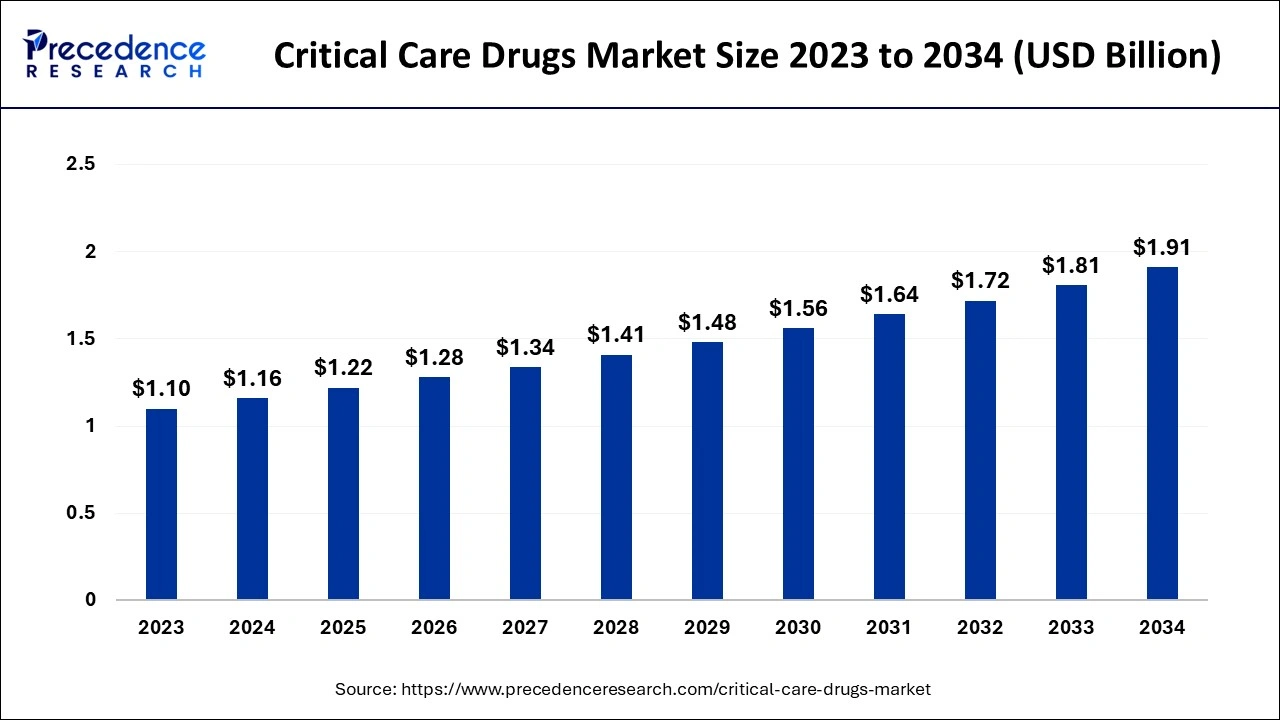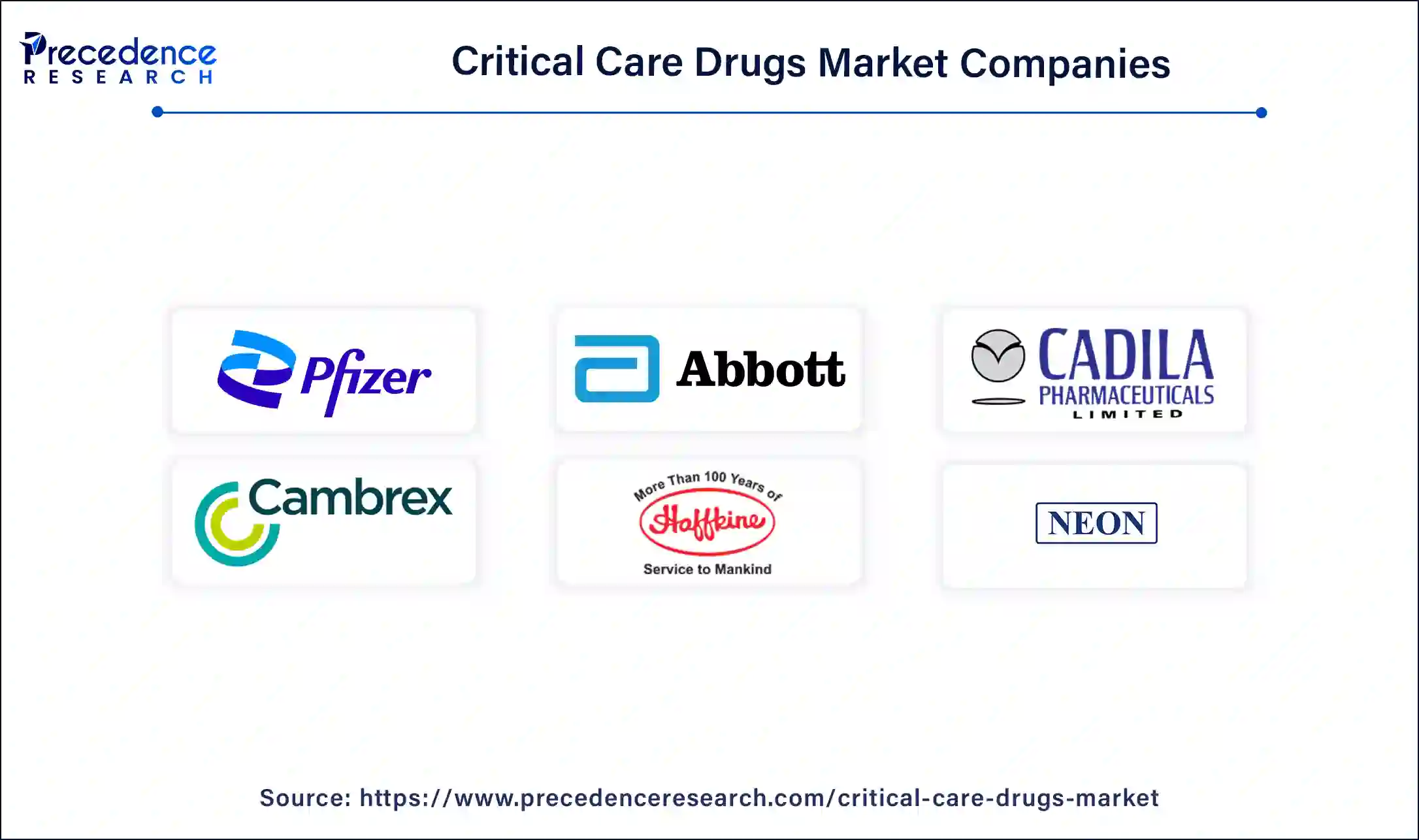January 2025
The global critical care drugs market size accounted for USD 1.16 billion in 2024, grew to USD 1.22 billion in 2025 and is expected to be worth around USD 1.91 billion by 2034, registering a CAGR of 5.12% between 2024 and 2034.
The global critical care drugs market size is calculated at USD 1.16 billion in 2024 and is projected to hit around USD 1.91 billion by 2034, expanding at a CAGR of 5.12% from 2024 to 2034. The critical care drugs market is driven by the world's population is aging quickly, and the prevalence of chronic illnesses and lifestyle-related ailments is rising.

The pharmaceutical industry segment that focuses on products created especially to treat patients with life-threatening diseases or severe medical difficulties requiring close monitoring and intervention is the critical care drugs market. This covers medications used in essential care environments, including surgical recovery rooms, emergency rooms, and intensive care units.
Stabilizing patients in life-threatening circumstances requires the use of critical care medications. They can significantly increase survival rates and improve recovery results when taken on time. The need for critical care drugs market services and related drugs rises as the world's population ages. Severe health problems that require necessary care are more common in older people.
How is AI Helping the Growth of the Critical Care Drugs Market?
Massive databases can be more effectively analyzed by AI systems to find possible medication candidates in the critical care drugs market. Developing novel critical care medications may be sped up using machine learning algorithms to forecast how various substances interact with biological targets and helps in improving inventory control and the supply chain for critical care medications, ensuring that hospitals have the necessary prescriptions on hand when they're needed. It helps generate customized treatment plans by analyzing each patient's medical history and genetic data. This personalization can improve treatment outcomes in critical care situations.
| Report Coverage | Details |
| Market Size by 2034 | USD 1.91 Billion |
| Market Size in 2024 | USD 1.16 Billion |
| Market Size in 2025 | USD 1.22 Billion |
| Market Growth Rate from 2024 to 2034 | CAGR of 5.12% |
| Largest Market | North America |
| Base Year | 2023 |
| Forecast Period | 2024 to 2034 |
| Segments Covered | Drug Type, End-user, and Regions |
| Regions Covered | North America, Europe, Asia-Pacific, Latin America and Middle East & Africa |
Increasing prevalence of chronic diseases
Acute crises can arise from systemic consequences or multi-organ dysfunction, which is common in chronic disorders. Basically, in an intensive care unit (ICU), patients with chronic illnesses need continuous monitoring and prompt pharmaceutical intervention because they are more likely to experience abrupt deterioration. This fuels the need for different types of critical care drugs market services. Demand is sometimes further increased by insurance incentives or subsidies that make critical care drugs more affordable for people with chronic illnesses.
Rising number of surgeries
As more diseases require surgical procedures, there is an increase in the number of surgeries being performed worldwide. This includes organ transplants, orthopedic surgery (particularly joint replacements), cardiovascular surgery, and cancer surgery. For example, angioplasty and bypass surgery are among the increasingly prevalent surgical procedures used to treat cardiovascular disorders, which are the world's leading cause of mortality. Because older patients typically stay in the hospital longer after surgery, there is a greater need for critical care medications such as antibiotics, sedatives, and anticoagulants during their prolonged recuperation in intensive care units (ICUs).
Limited accessibility of critical care drugs
Critical care drugs market products are easily obtained in developed countries, and so access to them is limited in low- and middle-income countries. The distribution networks, infrastructure, and healthcare systems needed to effectively provide and distribute these drugs are usually lacking in developing nations. As a result, patient results differ by region. Countries have different regulations, and manufacturers often have to adjust their products and processes to meet local standards. This is the reason for the delay in product introductions in some regions, the increase in the cost, and the difficulty of delivering critical care drugs abroad.
Advancement in the development of innovative drug
The development of advanced drug delivery techniques, like controlled-release formulations and nanotechnology, has made it possible to provide critical care drugs market services more successfully. These systems can enhance drug absorption, lessen side effects, and give long-lasting therapeutic effectiveness. Numerous cutting-edge medications that treat uncommon and fatal illnesses are granted orphan drug designation, which offers benefits including tax breaks and commercial exclusivity and encourages investment in the market for critical care medications.
The opioids segment dominated the global critical care drugs market in 2023. Since opioids are among the most potent painkillers, they are crucial in critical care situations. Opioids are frequently the medication of choice in critical care units (ICUs) for patients on mechanical ventilation, post-surgical recovery, and severe trauma. They are broadly used to treat post-operative pain, particularly following major surgeries such as orthopedic, cardiac, or gastrointestinal procedures. Opioids provide quick relief from severe pain after surgery, which is essential for the patient's recovery.
The sedatives segment will show significant growth in the critical care drugs market during the forecast period. The need for sedatives is directly impacted by the growing number of patients in critical care units, which is mainly brought on by an older population, the prevalence of chronic illnesses, and a rise in trauma and surgical procedures. ICU patients frequently need sedation to control their pain, anxiety, and discomfort. Sedatives are crucial for treating acute pain and anxiety and ventilator support in patients who are admitted to critical care due to the prevalence of trauma from accidents or violent crimes.
The intensive care unit (ICU) segment dominated the critical care drugs market in 2023. Patients with life-threatening illnesses that need extensive care, round-the-clock monitoring, and quick therapeutic interventions are treated in intensive care units. These patients are heavily dependent on critical care medications because they frequently have multiple organ dysfunctions, sepsis, severe infections, respiratory failure, cardiac problems, or trauma. The need for drugs like vasopressors, inotropes, sedatives, analgesics, and anticoagulants is fueled by their severe diseases. The use of critical care drugs has increased due to the development of intensive care unit technologies, including mechanical ventilation, extracorporeal membrane oxygenation (ECMO), sophisticated monitoring systems, and other life-support systems. Longer patient survival and recovery are made possible by these technologies, but they also lead to a dependence on expensive medications that are given in carefully monitored, critical care environments.
The coronary care unit (CCU) segment will witness significant growth in the critical care drugs market during the forecast period. The prevalence of heart disease rises as the world's population ages, especially in affluent nations. Because heart problems are more common in older persons, there is a greater need for specialist care in critical care units (CCUs) and, consequently, for critical care medications such as anticoagulants, vasodilators, and antiarrhythmics. In critical care, it is important to integrate drugs with medical devices such as cardiac pumps and drug-eluting stents. To prevent thrombosis and other problems, these devices frequently call for supplemental pharmaceutical interventions, which support the use of drugs in critical care units.
North America dominated the critical care drugs market in 2023. Some of the most cutting-edge ICUs and hospitals in the world are found in North America, particularly in the United States and Canada. The need for critical care medications is driven by critical situations like sepsis, respiratory failure, and severe trauma, all of which these facilities are well-equipped to address. Although North American healthcare systems differ, a sizable section of the populace is covered by government programs such as Medicaid and Medicare or private insurance (United States), which give access to critical care medications, particularly for the elderly or seriously ill.
Asia Pacific is observed to host the fastest-growing critical care drugs market during the forecast period. Chronic illnesses such as cancer and respiratory conditions are becoming more common in Asia Pacific. The requirement for critical care medications is propelled by these diseases, which frequently result in serious problems that call for urgent care and crucial interventions. Due to increased disposable incomes from the region's economic growth, residents can now afford to spend more on healthcare services, especially cutting-edge procedures, including critical care medications.

Segments Covered in the Report
By Drug Type
By End-user
By Geography
For inquiries regarding discounts, bulk purchases, or customization requests, please contact us at sales@precedenceresearch.com
No cookie-cutter, only authentic analysis – take the 1st step to become a Precedence Research client
January 2025
October 2024
March 2024
January 2025